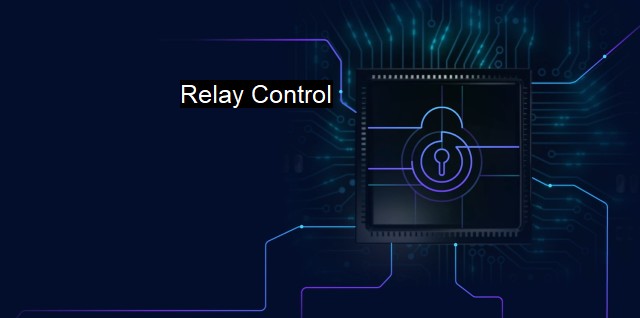What is Relay Control?
Securing Networks with Relay Control: Protecting Against Malware and Unauthorized Access
Relay control can be described as the management of commands between different devices and channels. It carries significance in many contexts including cybersecurity and antivirus where it ensures strong communication flow among different components of a security system. It acts as a regulating measure intended to regulate connections and process communications in a coordinated manner, thereby improving the overall performance of the system and its security.Relay control particularly has profound implications in cybersecurity. In any system's security infrastructure, it's paramount to establish effective communication between the different system's endpoints. the reality is that most networks host both legitimate and malicious activities. Some of these malicious activities are directed towards manipulating the relay control. For instance, attackers tend to exploit relay control commands to sell or distribute malware, smash system defenses, spam links, or even facilitate Distributed Denial of Service (DDoS) attacks. Certain cybersecurity mechanisms are required to combat such malicious activities, hence the need for a heightened level of relay control.
Antivirus software also employs relay control to identify and neutralize potential threats in an interconnected system. Antivirus programs must possess the capability to send commands that can be reliably received and actioned by different components of a system. For instance, if an antivirus program detects a potential threat, it would need to swiftly relay this information to all facets of the system, issuing commands like terminating ongoing processes, isolating certain segments of the network, or resetting particular functions to limit the reach of the threat.
Acting as a liaison between the security software and the user's network, relay control plays a critical function in maintaining system security. For effective relay control in terms of cybersecurity and antivirus, efficient and reliable protocols are vital. Forming the basis for command execution, protocols establish procedures for any command or function that needs to be carried out. Relay control protocols are typically designed to guarantee the authentic and optimal functioning of antivirus and cybersecurity programs.
Attackers are consistently refining their tactics to exploit the vulnerabilities that can potentially exist within relay control protocols. Therefore, the development of relay control measures must also adapt, becoming as dynamic as the threats they aim to neutralize. This is achieved through continuous testing and updates to ensure that relay control systems can capably manage new, evolving threats.
Nowadays, many modern cybersecurity and antivirus solutions use machine learning and artificial intelligence technologies to improve relay control. Machine learning algorithms are utilized to analyze outgoing and incoming traffic, flagging abnormalities which could potentially indicate malicious activity. On the other hand, artificial intelligence is used to identify new threats by learning the common characteristics of malicious activities then forming built-in defenses against them.
The importance of relay control in cybersecurity and antivirus cannot be underestimated. With the constantly evolving cyber threats, relay control plays a crucial role in maintaining system security by facilitating authentic and secure communication between different components of a security system, and managing any communication that may appear suspicious. By managing and deploying commands between system nodes, relay control ensures not just a robust defense system, but also a method to respond to potential and existing threats efficiently.
Relay control represents a substantial area in cybersecurity and antivirus protection. From curbing random unauthorized activities to safeguarding authentic communication, relay control upholds the integrity of a system and its surrounding networks. Its continuous evolution and adaptation are cardinal for forming formidable defenses against cyber threats, ushering in a new era of system security at the forefront of technological innovation.

Relay Control FAQs
What is a relay control in the context of cybersecurity and antivirus?
In the context of cybersecurity and antivirus, a relay control refers to the ability to remotely control a system or device through a relay, which is a switch that can be activated through an external signal. In other words, it allows an attacker to take control of a system or device from a remote location.Why is relay control a concern for cybersecurity and antivirus?
Relay control is a concern for cybersecurity and antivirus because it can be used by attackers to take control of a system or device without physical access. This can lead to various security breaches, such as unauthorized access, data theft, or damage to the system or device.How can relay control be prevented in cybersecurity and antivirus?
Relay control can be prevented in cybersecurity and antivirus by implementing secure protocols and access controls, such as authentication and encryption. Additionally, monitoring network traffic and detecting abnormal behavior can help detect and prevent relay control attacks.What are some examples of relay control attacks in cybersecurity and antivirus?
Some examples of relay control attacks in cybersecurity and antivirus include malware that uses command and control servers to remotely control infected devices, as well as attacks that exploit vulnerabilities in remote administration protocols, such as Remote Desktop Protocol (RDP) or Virtual Network Computing (VNC). Other examples include attacks that use phishing or social engineering to trick users into installing malicious software or providing access credentials.| | A | | | B | | | C | | | D | | | E | | | F | | | G | | | H | | | I | | | J | | | K | | | L | | | M | |
| | N | | | O | | | P | | | Q | | | R | | | S | | | T | | | U | | | V | | | W | | | X | | | Y | | | Z | |
| | 1 | | | 2 | | | 3 | | | 4 | | | 7 | | | 8 | | |||||||